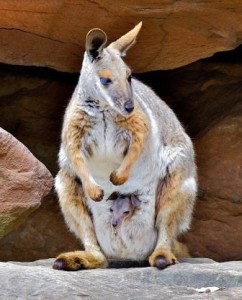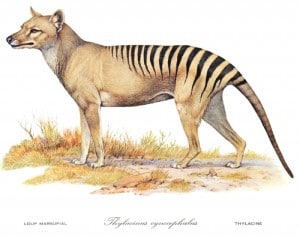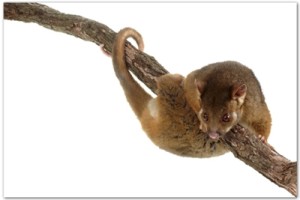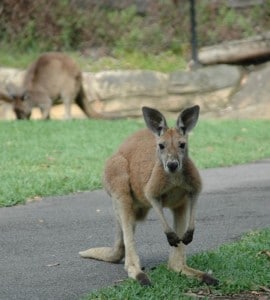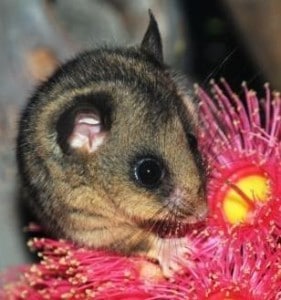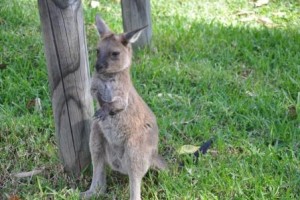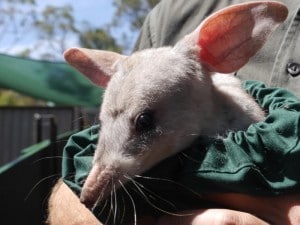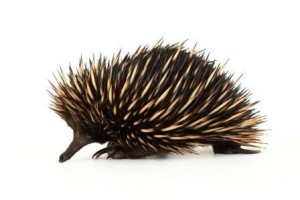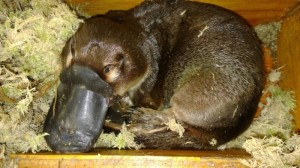-
Yellow-footed rock-wallaby
Scientific Name: Petrogale xanthopus The largest of the wallabies, the yellow-footed rock wallaby also has the most colourful markings. Its tail is ringed brown and yellow, its paws are yellow and its back is covered in soft grey fur. Its underbelly is white and there are white stripes on the
Tasmanian Tiger
Scientific Name: Thylacinus cynocephalus (extinct – interactive display only) Perhaps the most mysterious Australian mammal is the Thylacine, or Tasmanian Tiger, which is considered to have become extinct in 1936. The Thylacine resembled a large, short-haired dog with a stiff tail which extended from the body in a way similar
Ringtail possum
Scientific Name: Pseudocheirus peregrinus The ringtail possum, along with the common brushtail possum, is a familiar face in Australian backyards. About the size of a large rabbit, they are smaller than brushtail possums and distinguished by their long, white-tipped tails. When they’re not using their prehensile tail to hold onto
Red kangaroo
Scientific Name: Macropus rufus The world famous red kangaroo is the largest marsupial and the largest Australian mammal, with some males standing at two metres tall, and weighing around 85 kilograms. Males are bigger than females and are very powerfully built. The fur is usually red-brown, though some eastern females
Mountain Pygmy possum
Scientific Name: (Burramys parvus) The Mountain Pygmy-possum is mainly grey-brown with paler grey/brown to cream underneath. Its fur is fine but very dense keeping the animal warm in sometimes freezing temperatures. It has a darker ring of fur around its eyes, rounded ears and a long tail. The Mountain Pygmy-possum
Kangaroo Island kangaroo
Scientific Name: Macropus fuliginosus The Kangaroo Island kangaroo is found only on Kangaroo Island, off the South Australian Coast. With no natural predators, the kangaroos are the slowest moving kangaroo species. They are closely related to the western grey kangaroo on the nearby mainland, but are typically smaller and sturdier.
Greater Bilby
Scientific Name: (Macrotis lagotis) The Greater Bilby is about the size of a rabbit with soft blue-grey fur. It has large, elongated ears with white fur underneath and a long black tail with a white tip. It has a long, pointed snout and forelimbs adapted for burrowing with 3 strong,
Feathertail Glider
Scientific Name: (Acrobates pygmaeus) The Feathertail glider is a tiny gliding marsupial and the smallest in the world. It is the size of a small mouse growing to a maximum of 80mm and a weight of only 15g. Its unique tail resembles a feather, with stiff, tiny hairs horizontal on
Echidna
Scientific Name: Tachyglossus aculeatus Echidnas or spiny anteaters can grow to about 40cm long and weigh up to 7 kilograms. It has a bare, tube-like snout and a long, sticky tongue. The feet are dark and have a set of powerful black claws. The second claw on each hind foot
Platypus
Scientific Name: Ornithorhynchus anatinus Proudly Sponsored by Brenna Tarrant, Blaxland NSW Azalea and Shira Akbarian, Kariong Azalea and Shira Akbarian, Kariong Did You Know? The male platypus has a spur on the inside of its hind leg which is it’s only defence. The spur contains poisonous toxins that can cause
- 1
- 2

